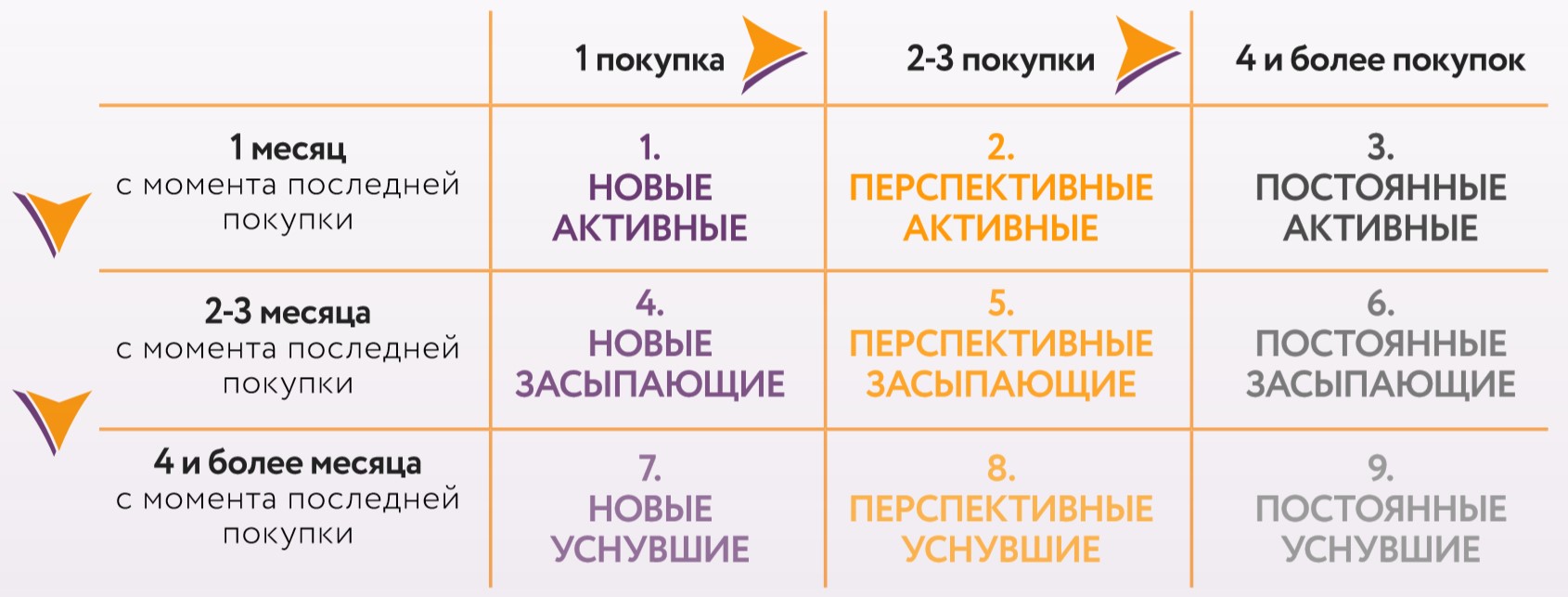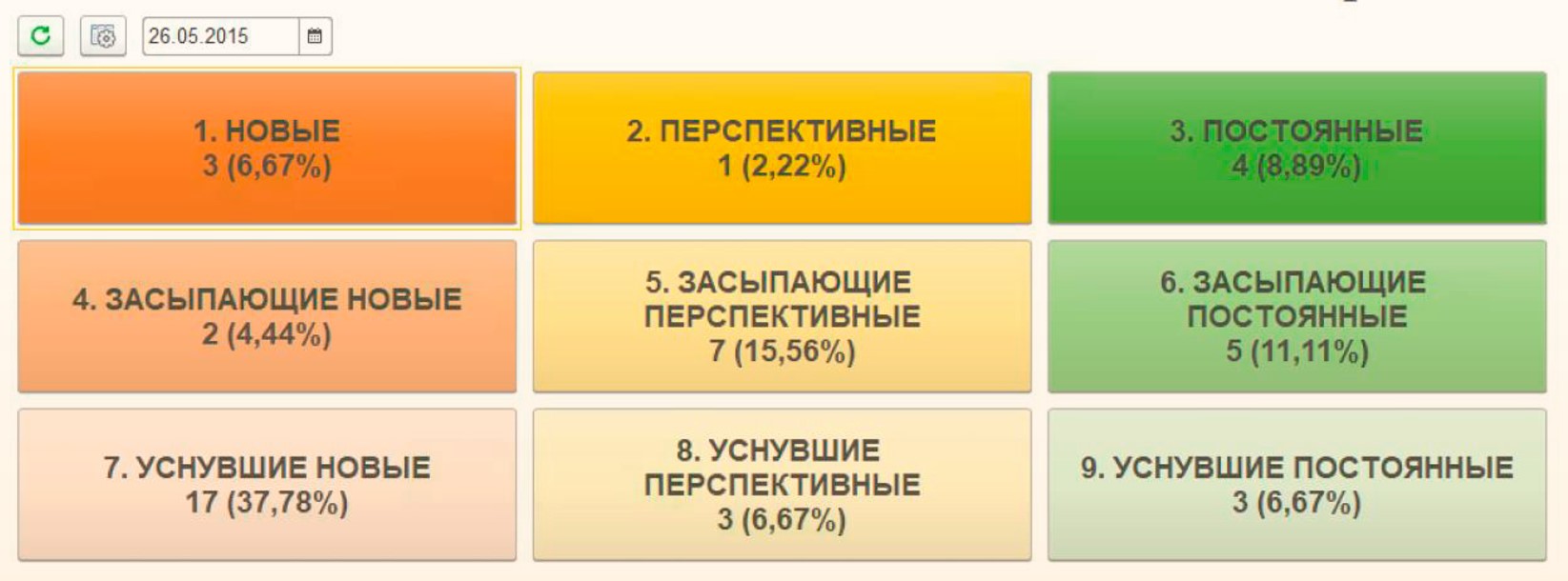Think about how you would answer the question: "What does it take to regularly interact with hundreds and thousands of customers?" I will talk about two useful tools for working with loyal customers: Segmentation and Customer campaigns .
To work successfully with a large customer base, you need to be able to organize work with customers in the format of "customer campaigns". This approach is widely used in both sales and marketing.
Client campaigns is a technology that allows you to organize and automate the process of communication with “target clients”.
Segmentation is the division of clients into groups for the convenience of analysis or organization of interaction. Depending on the goals of interaction, you can divide a large database between “target” and “non-target” clients.
For example, if our task is to offer a 10% New Year discount only for regular customers, then we need to make a list of customers who have bought 3 or more times. Such a list (segment) will be the “target segment” for the task of conducting a survey among “regular customers”, and the process of calling such customers is a customer campaign.
The organization of re-sales contains many regularly repeated tasks with target segments, so this work needs to be organized in the format of client campaigns.
Work with regular customers is often organized in the format once a week or once a month, therefore, in order not to remember every time what needs to be done, it is necessary to solve 3 problems:
- Define “target segments”.
- Define a list of practical actions for each “target segment”.
- Automate work with regular customers!
Let us examine the first task in detail - the definition of "target segments" .
At this stage, we need to ask which customers are important to us, formulate criteria for selecting “target segments” and remember to automate the segmentation of the customer base. Ideally, we want a report that allows us to get an up-to-date list of target customers with the click of a button.
You can segment your customer base according to various criteria: customer position, age, consumer habits, geographic location, religion, etc. The more data is provided about the client, the more individual approach to him can be selected. But that's in theory! In practice, collecting and keeping up to date such versatile information about a client is difficult. You can, for example, ask the buyer to fill out a questionnaire before the first purchase or to receive a gift, but this is time consuming and expensive. There is a better way!
Any company has reliable analytics that we can use to segment and drive repeat sales! This is information about sales - the number of purchases and the date of each purchase.
The number of purchases and the duration of the last purchase allow segmentation of customers using the Customer Life Cycle methodology.
The idea of segmentation by stages of the Customer Life Cycle is based on the fact that there are clear differences in the behavior of customers who bought from us "yesterday" or, for example, "a year ago."
Also, the behavior depends on the number of purchases. If a client bought once, he will be more wary of our offers, and the one who bought 3-4 times can reasonably be considered loyal and it is easier to talk to him!
Having identified 3 segments for “Number of purchases” and 3 segments for “Elapsed time of last purchase”, we get a table of 9 segments. Segments should be defined so that the behavior and expectations of customers in each segment are different from the neighboring segment.
An example of a setting is a matrix for E-commers.
Matrix "9 segments of life cycle"

In the "New Active" segment we will receive a list of customers who have bought recently and only once. The needs and expectations of these customers are very different, for example, from the segment "Constant Sleepers", who in this case bought something from us at least 4 times, and the last purchase was 2-3 months ago! Obviously, you need to talk to these customers in different ways and the tasks of Repeat sales are also different.
The recommended values for these parameters "Number of purchases" and "Elapse of purchase" differ for different businesses. The optimal values of the parameters "Number of purchases" and "Elapse of purchase" can be determined expertly or based on the analysis of sales for long periods.
An example of a repeat sales report in 1C

The report allows you to get lists of segments for organizing calls, e-mails and remarketing. Any list can be obtained by pressing one button, the list is always up-to-date.
Analyzing the report will allow you to determine the quality of Engagement and Retention. For example, it is good if your company's active customer base is at least 30%.
Based on the analysis results, you will be able to formulate and identify priority areas for marketing and sales in the field of repeat sales and formulate tasks for marketing and sales. We advise you to fix the objectives and criteria for success (KPI "Repeat sales") in writing. Those. fix the strategy of interaction with target segments.
The second task after defining "target segments" is to develop a strategyfor each customer segment. A list of practical actions should be identified for each client group. For example, it is useful to agree on which customers need to be called, and for which it is enough to send a letter or "talk" through a chat bot.
Each customer segment requires a unique engagement strategy. For communication with the client, calls are organized, satisfaction assessments, mailings, remarketing, etc.
Let's give an example for several segments.
New active customers are buyers who have purchased the product recently and for the first time. For this segment, it is necessary to provide support at the initial stage, help to master the product, and start building relationships.
Consider the category of promising falling asleep clients, which bought several times, but since then some time has passed. To return them, you should send personalized emails with recommendations for other products, inform about offers under the loyalty program, make time-limited special offers.
The last category we will look at will be regular sleeping customers who have already made a lot of purchases, but have not returned for a long time. For this segment, it is recommended to win back customers using reactivation tools. Don't lose them in the competition, talk to them!
The third, final task for organizing repeat sales is process automationregular launch of client campaigns for selected segments. Processes for regularly launching client campaigns for selected segments. Many communications can be automated and it is imperative to do this, wherever possible.
After the strategies are approved, it is desirable to automate business processes for interacting with customer segments, for example, set up automatic mailing of letters about a new product line, useful news to prospective customers, set a reminder of periodic calls to falling asleep customers, etc.
Thus, the technology of client companies is an excellent solution for automating work with hundreds and thousands of different clients.